Lily-Like Monocots
Also known as the Lily family.
Usually herbs.
- Stems are often modified as rhizomes, bulbs, or corms. Leaves are often linear or strap shaped, simple, usually alternate, but may be basal or whorled, without stipules.
- Flowers usually perfect, radially symmetrical, tepals 6, free of partially fused, or sometimes a hypanthium present. Stamens 6 (rarely 3). Pistil compound, ovary superior or inferior (those with umbellate inflorescences and inferior ovaries are often put in the Amaryllidaceae), carpels 3, placentation axile.
- Fruit a capsule or berry.
- About 240 genera and 4,200 species, widely distributed.
The Liliaceae is the fourteenth largest family in B. C., with 59 species. In B. C. it is easily recognized by the petalloid flower parts in multiples of 3, the 6 stamens, and the superior ovary. Many of our most spectacular wildflowers are members of the Liliaceae, including Lilium (lily), Calochortus(mariposa lily), Camassia (camas), and Erythronium (glacier lily, dogtooth violet). Many genera are cultivated as ornamentals, such as Lilium (lily),Tulipa (tulip), Hyacinthus (hyacinth), Narcissus (daffodils, narcissus), and Amaryllis. Narcissus and Amaryllis are often put in a segregate family, the Amaryllidaceae. Cultivated crops include onions, chives, leeks, garlic, shallots (various species of Allium), and Asparagus (asparagus).
Lily
| Lily |
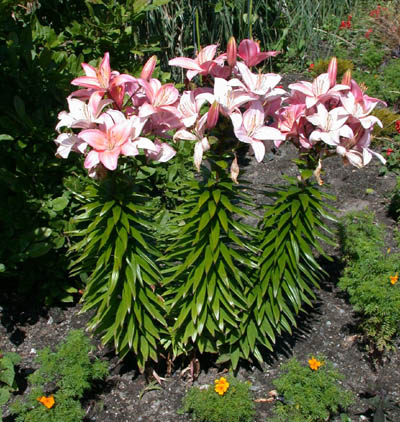 Lily flowers |
| A lovely white lily: |
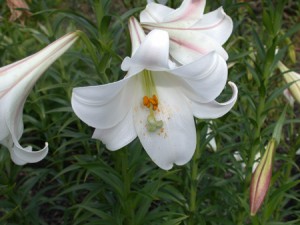 |
| A close-up of the stigma: |
 Close Up of the Stigma of a Lily |
| The nectaries of the Liliaceae (in the strict sense) are commonly found on the tepals. |
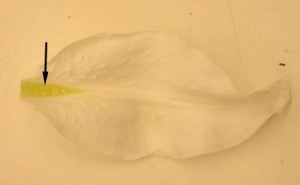 Nectary on the Tepal |
| A close-up of the nectary, note the wet nectar: |
 Nectary, Close up |
| A versatile anther: |
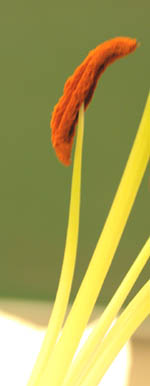 Versatile Anther |
| A capsule of Cardiocrinum |
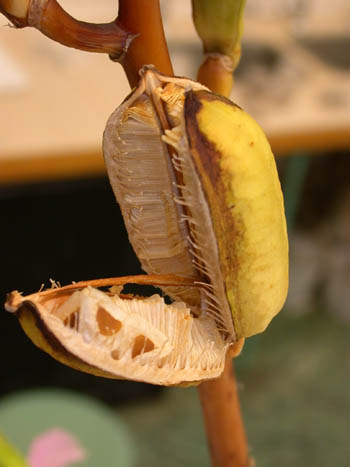 Capsule |
| The seeds are very flat. The arrow indicates a row of them in the capsule. |
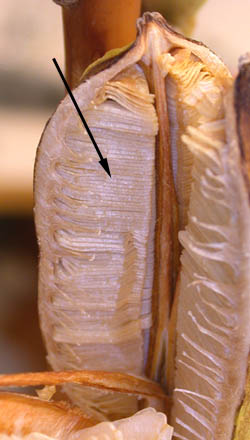 Seeds in the Capsule |
| Here is a pile of seeds (note the winged edge. |
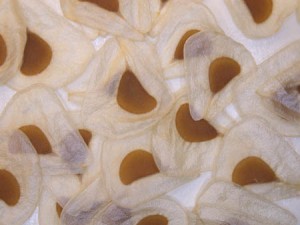 Flat Seeds |
Bulbs vs. Corms
| Bulbs: |
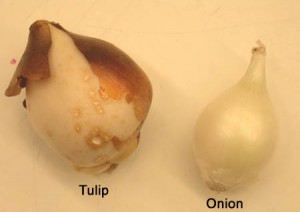 Bulbs |
| Corms from Crocus(actually from the Iridaceae): |
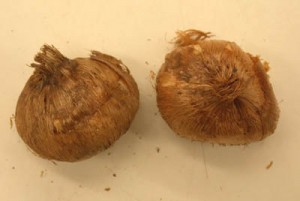 Corms |
| Longitudinal section through a bulb (left) and a corm (right) – What is the difference between the two?: |
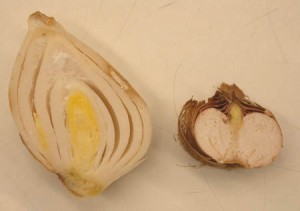 Bulbs and Corms, Longitudinal Section |
Other Members of the Liliaceae
Recently, the Liliaceae has undergone revision. In some of the newer classification systems a number of the following plants have been assigned to different families.
| Tricyrtis (Toad Lily) |
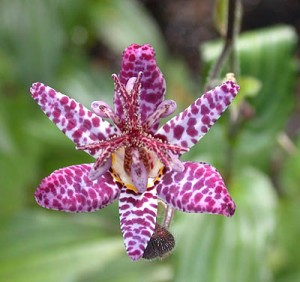 Toad Lily |
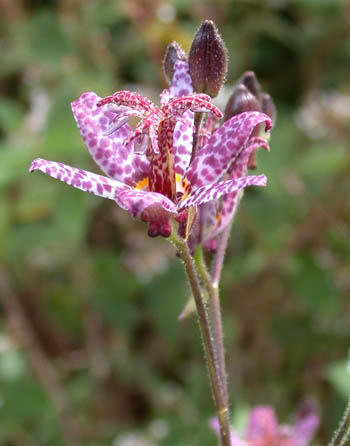
Toad Lily, Side View
Allium schoenoprasum (chives)
This European plant is widespread throughout the northern hemisphere. |
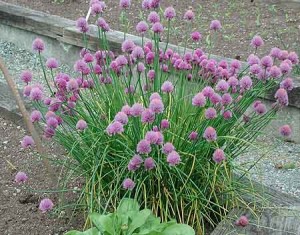 Chive Plant |
Allium cernuum(nodding onion)
The nodding onion is native to North america. It has rather small bulbs and was consumed by a limited number of groups of First Peoples. |
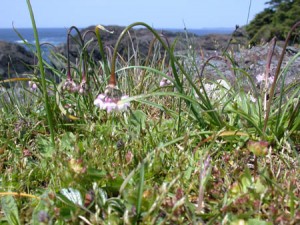 Nodding Onion |
| A close-up of this lovely inflorescence (Long Beach): |
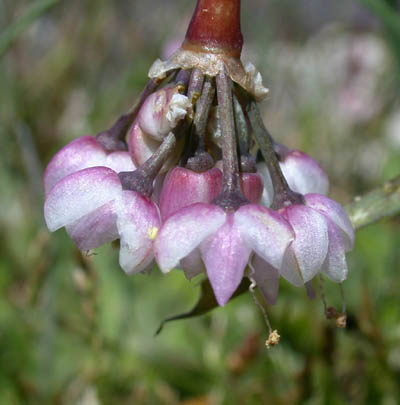 Nodding Onion, Close Up of Inflorescence |
| Allium cepium(Green Onion and Pearl Onion)These are variations of our common onion. This picture of green onion shows you adventious roots (common to the monocots). Adventitious roots are those that arise from the stem. |
 Adventitious Roots |
| Here is a pearl onion (excellent in antipasto). |
 Pearl Onion |
Narcissus (daffodil)
The daffodil is a favourite springtime flower. It has a long history with humans. flowers have been found in tombs from ancient Egypt. |
 Daffodil |
| Ovary cross-section showing the ovules which will develop into seeds. |
 Daffodil, Longitudinal Cross Section |
| Ovary. |
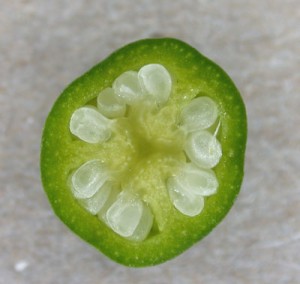 Cross Section, Daffodil Ovary |
| Tulipa (Tulip). The tulip has a colourful history. In the early 1550’s it was introduced to Vienna from Turkey by the ambassador of the Holy Roman Emperor. The flowers quickly caught on and became the craze of Europe. In fact people valued the tulip so much that it became very prestigious to own them. The price of tulips sky rocketed to ridiculous levels before the market collapsed. |
 Tulip |
| Lilium comlumbianum (Tiger Lily). This is a lily common to the Pacific Northwest. The first nations’s peoples would eat the They had a bitter flavour so were used more to flavour than a food item. |
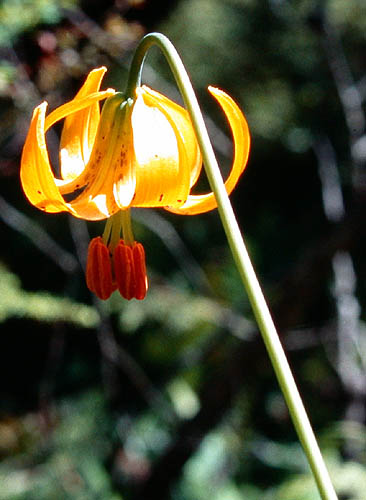 Tiger Lily |
| Trillium. This plant of the moist woodlands is always a delight to see in the spring. |
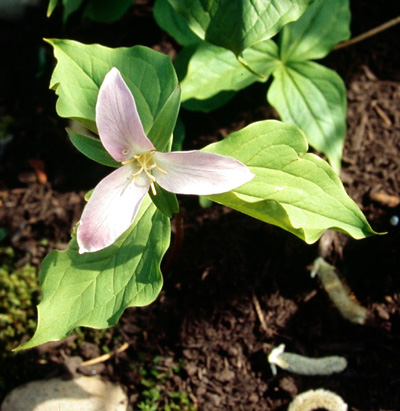 Trillium |
| Developing fruit (capsule): |
 Trillium, Developing Fruit |
Camassia (Camas Lily)
This lovely lily is common in meadows and grassy slopes. Its bulbs are edible, but caution must be taken when collecting them. A closely related species (Camassia is very poisonous when consumed. The flowers differ in colour, but the bulbs look very similar. |
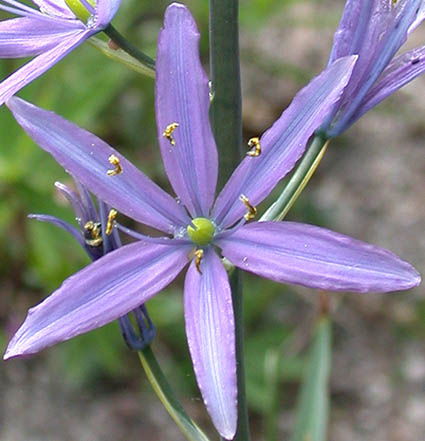 Camas lily |
Maianthemum (False Lily-of-the-family)
A common plant in shady woodlands. |
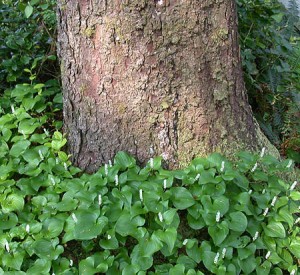 False lily of the Valley |
 False Lily of the Valley |
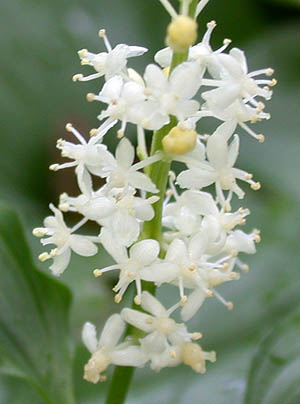 False Lily of the Valley, Close Up |
Convallaria (Lily-of-the-Valley)
This is the true lily-of-the-valley. It is rather nice introduction (beautiful fragrance) from Europe.. |
|
 Lily of the Valley |
| Fritillaria. |
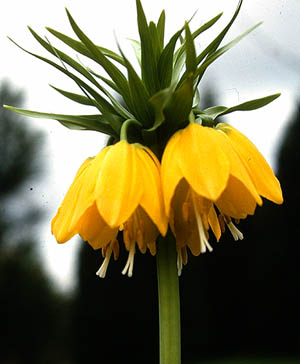 Fritillaria |
Alstromeria
Alstromeria was formerly in the Liliaceae, but now it is placed in its own family, Alstromeriaceae. |
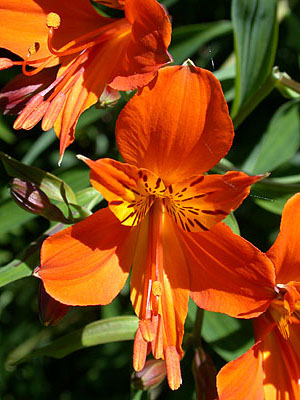 Alstomeria |
Back to Lab 5

































